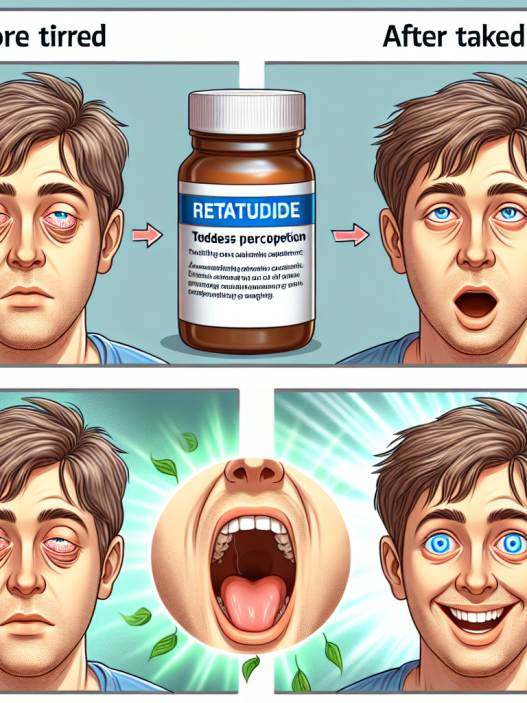-
Table of Contents
«Alivia el dolor muscular con opciones de tratamiento adecuadas para el uso de Metformin Hydrochlorid.»
Introduction
Metformin Hydrochloride is a commonly prescribed medication for the treatment of type 2 diabetes. However, some individuals may experience muscle pain as a side effect of taking this medication. In this case, it is important to know what steps to take in order to alleviate this discomfort and continue with the treatment. In this article, we will discuss what to do if Metformin Hydrochloride is causing muscle pain.
Managing Muscle Pain While Taking Metformin Hydrochloride: Tips and Tricks
Metformin Hydrochloride is a commonly prescribed medication for the treatment of type 2 diabetes. It works by helping the body use insulin more effectively and lowering blood sugar levels. While it is an effective medication for managing diabetes, some people may experience side effects, including muscle pain. If you are experiencing muscle pain while taking Metformin Hydrochloride, here are some tips and tricks to help manage it.
First and foremost, it is important to consult with your doctor if you are experiencing muscle pain while taking Metformin Hydrochloride. They can help determine if the medication is the cause of your pain or if there may be another underlying issue. Your doctor may also adjust your dosage or prescribe a different medication to help alleviate the pain.
One of the most common causes of muscle pain while taking Metformin Hydrochloride is lactic acidosis. This is a buildup of lactic acid in the body, which can cause muscle pain, weakness, and cramping. To prevent lactic acidosis, it is important to stay hydrated and avoid excessive alcohol consumption. Drinking plenty of water can help flush out lactic acid from the body and reduce the risk of muscle pain.
Another way to manage muscle pain while taking Metformin Hydrochloride is to incorporate regular exercise into your routine. Exercise can help strengthen muscles and improve overall muscle function. It can also help reduce the risk of lactic acidosis. However, it is important to start slowly and gradually increase the intensity of your workouts. Consult with your doctor or a certified trainer to develop an exercise plan that is safe and effective for you.
In addition to exercise, stretching can also help alleviate muscle pain. Stretching can improve flexibility and range of motion, which can help reduce muscle tension and pain. It is important to stretch before and after exercise to prevent injury and reduce muscle soreness. You can also incorporate gentle stretching exercises throughout the day to help manage muscle pain.
Applying heat or ice to the affected area can also provide relief from muscle pain. Heat can help relax muscles and improve blood flow, while ice can help reduce inflammation and numb the pain. You can alternate between heat and ice therapy to find what works best for you. It is important to not apply heat or ice directly to the skin and to limit the duration of each therapy to 20 minutes at a time.
In some cases, over-the-counter pain relievers may be necessary to manage muscle pain while taking Metformin Hydrochloride. However, it is important to consult with your doctor before taking any medication, as they can interact with Metformin and other medications you may be taking. Your doctor may also prescribe a muscle relaxant to help alleviate the pain.
In addition to these tips and tricks, it is important to maintain a healthy lifestyle while taking Metformin Hydrochloride. This includes eating a balanced diet, getting enough rest, and managing stress levels. A healthy lifestyle can help improve overall muscle function and reduce the risk of muscle pain.
In conclusion, muscle pain while taking Metformin Hydrochloride can be managed with the help of your doctor and by incorporating certain lifestyle changes. Staying hydrated, exercising regularly, stretching, applying heat or ice, and taking over-the-counter pain relievers can all help alleviate muscle pain. It is important to consult with your doctor before making any changes to your medication or lifestyle. With proper management, you can continue to effectively manage your diabetes while minimizing muscle pain.
Alternative Medications for Diabetes Management: Exploring Options Beyond Metformin Hydrochloride
Metformin Hydrochloride is a commonly prescribed medication for the management of type 2 diabetes. It is known for its effectiveness in lowering blood sugar levels and improving insulin sensitivity. However, like any medication, it can also come with side effects. One of the most common side effects of Metformin Hydrochloride is muscle pain or discomfort. This can be a frustrating and uncomfortable experience for those taking the medication. If you are experiencing muscle pain while taking Metformin Hydrochloride, there are alternative medications that you can explore with your doctor.
Before we delve into alternative medications, it is important to understand why Metformin Hydrochloride can cause muscle pain. The exact mechanism is not fully understood, but it is believed that the medication can cause a decrease in the production of Coenzyme Q10 (CoQ10) in the body. CoQ10 is an enzyme that is essential for energy production in the muscles. When there is a decrease in CoQ10, it can lead to muscle pain and discomfort.
If you are experiencing muscle pain while taking Metformin Hydrochloride, the first step is to consult with your doctor. They will be able to assess your symptoms and determine if the muscle pain is indeed caused by the medication. If it is, they may suggest alternative medications for diabetes management.
One alternative medication that has been found to be effective in managing type 2 diabetes is DPP-4 inhibitors. These medications work by increasing the levels of incretin hormones in the body, which help to regulate blood sugar levels. Unlike Metformin Hydrochloride, DPP-4 inhibitors do not affect CoQ10 levels in the body, making them a good option for those experiencing muscle pain.
Another option is GLP-1 receptor agonists. These medications also work by increasing the levels of incretin hormones in the body. They have been found to be effective in lowering blood sugar levels and promoting weight loss. Like DPP-4 inhibitors, GLP-1 receptor agonists do not affect CoQ10 levels in the body, making them a suitable alternative for those experiencing muscle pain.
SGLT2 inhibitors are another class of medications that can be considered as an alternative to Metformin Hydrochloride. These medications work by preventing the kidneys from reabsorbing glucose, leading to lower blood sugar levels. They have also been found to have a positive effect on heart health. However, it is important to note that SGLT2 inhibitors can increase the risk of urinary tract infections and yeast infections in some individuals.
Aside from these alternative medications, there are also natural remedies that can help alleviate muscle pain caused by Metformin Hydrochloride. CoQ10 supplements can be taken to increase the levels of this enzyme in the body. Additionally, incorporating regular exercise and a healthy diet can also help improve muscle pain and overall health.
It is important to remember that every individual is different, and what works for one person may not work for another. It is crucial to work closely with your doctor to find the best alternative medication for your specific needs. They will be able to assess your medical history, current medications, and any other underlying conditions to determine the most suitable option for you.
In conclusion, while Metformin Hydrochloride is an effective medication for managing type 2 diabetes, it can also come with side effects such as muscle pain. If you are experiencing this side effect, it is important to consult with your doctor to explore alternative medications. DPP-4 inhibitors, GLP-1 receptor agonists, and SGLT2 inhibitors are all viable options that do not affect CoQ10 levels in the body. Additionally, incorporating natural remedies such as CoQ10 supplements, exercise, and a healthy diet can also help alleviate muscle pain. Remember to always work closely with your doctor to find the best treatment plan for your individual needs.
The Importance of Regular Exercise and Stretching for Minimizing Metformin Hydrochloride-Related Muscle Pain
Metformin Hydrochloride is a commonly prescribed medication for individuals with type 2 diabetes. It works by helping the body use insulin more effectively and lowering blood sugar levels. While it is an effective medication for managing diabetes, one of the common side effects of Metformin Hydrochloride is muscle pain. This can be a frustrating and uncomfortable experience for those taking the medication. However, there are steps that can be taken to minimize this side effect and improve overall well-being.
One of the most important things to keep in mind when taking Metformin Hydrochloride is the importance of regular exercise. Exercise has numerous benefits for individuals with diabetes, including improving insulin sensitivity and lowering blood sugar levels. It also helps to strengthen muscles and improve overall physical health. By incorporating regular exercise into your routine, you can help to minimize the muscle pain associated with Metformin Hydrochloride.
When starting an exercise routine, it is important to start slowly and gradually increase intensity. This is especially important for individuals who are experiencing muscle pain from Metformin Hydrochloride. Starting with low-impact exercises such as walking, swimming, or cycling can help to build strength and endurance without putting too much strain on the muscles. As your body becomes accustomed to the exercise, you can gradually increase the intensity and duration of your workouts.
In addition to regular exercise, stretching is also crucial for minimizing muscle pain caused by Metformin Hydrochloride. Stretching helps to improve flexibility and range of motion, which can help to alleviate muscle tension and soreness. It is recommended to stretch before and after exercise, as well as throughout the day. Simple stretches such as shoulder rolls, neck stretches, and hamstring stretches can be done at home or at work to help relieve muscle pain.
Another important factor to consider is proper hydration. Dehydration can contribute to muscle pain and cramping, so it is important to drink plenty of water throughout the day. This is especially important when taking Metformin Hydrochloride, as the medication can cause dehydration as a side effect. Aim to drink at least 8 glasses of water per day and increase your intake if you are exercising or in hot weather.
In addition to exercise and stretching, there are other lifestyle changes that can help to minimize muscle pain caused by Metformin Hydrochloride. Maintaining a healthy diet rich in fruits, vegetables, and lean proteins can help to improve overall health and reduce inflammation in the body. Avoiding processed and sugary foods can also help to reduce muscle pain and improve overall well-being.
If you are experiencing severe muscle pain while taking Metformin Hydrochloride, it is important to speak with your doctor. They may be able to adjust your dosage or prescribe a different medication to help alleviate the pain. It is important to never stop taking your medication without consulting your doctor first.
In conclusion, while muscle pain is a common side effect of Metformin Hydrochloride, there are steps that can be taken to minimize its impact. Regular exercise, stretching, proper hydration, and a healthy diet can all help to alleviate muscle pain and improve overall well-being. It is important to consult with your doctor and make any necessary adjustments to your medication or lifestyle to ensure that you are managing your diabetes effectively and living a healthy, pain-free life.
Q&A
1. ¿Qué es Metformin Hydrochlorid y por qué puede causar dolor muscular?
Metformin Hydrochlorid es un medicamento oral utilizado para tratar la diabetes tipo 2. Puede causar dolor muscular como efecto secundario debido a su acción en el metabolismo de la glucosa y la reducción de la producción de ácido láctico en los músculos.
2. ¿Qué debo hacer si experimento dolor muscular mientras tomo Metformin Hydrochlorid?
Si experimenta dolor muscular mientras toma Metformin Hydrochlorid, es importante que consulte a su médico de inmediato. Pueden recomendar ajustar la dosis del medicamento o cambiar a un medicamento alternativo para tratar su diabetes.
3. ¿Hay alguna forma de prevenir o aliviar el dolor muscular causado por Metformin Hydrochlorid?
Si experimenta dolor muscular mientras toma Metformin Hydrochlorid, puede intentar tomar el medicamento con alimentos para reducir la irritación estomacal. También puede ser útil hacer ejercicio regularmente y mantener una dieta saludable para ayudar a controlar los niveles de glucosa en la sangre y reducir el riesgo de efectos secundarios. Si el dolor muscular persiste, es importante hablar con su médico para encontrar la mejor solución para usted.











